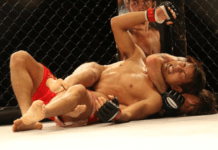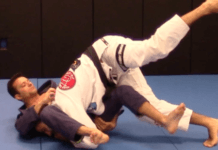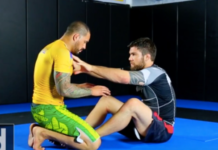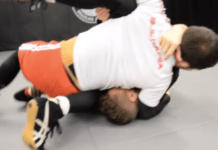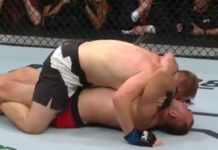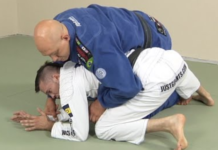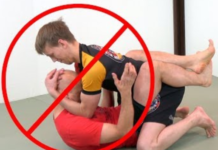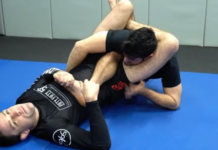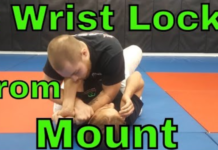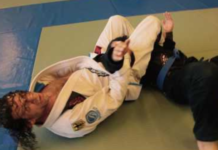Arm triangle choke also called side choke, and head and arm choke is one of the most basic (and most effective) submission holds that you will learn in BJJ. The name of the move is the name of the game – you will need to triangulate your opponent’s throat and neck with your opponent’s arm and your own arm at the same time. There are several variations of this move and below you will read about how best you can implement this move in your BJJ game.
Arm Triangle Choke – Variations
Arm triangle choke from the mount
One of the most basic and most effective ways in which you can implement the arm triangle choke is from the mount position in which you’re sitting on top of your opponent. In this scenario, you will need to start the move by doing the so-called “captain hook” or putting your arm behind your opponent’s neck. Be careful though because this will mean that you’re losing the opportunity to use your hooking arm for support, so your opponent can notice this and sweep you off to bottom guard.
Once you’re done setting up the captain hook, you will need to isolate your opponent’s opposite arm. You can use your other arm for this purpose – you can slowly but surely push your opponent’s arm upwards. Once you get to the point when his arm is on the level with his neck, you will need to block his arm with your head. And this creates the basic arm triangle choke mechanism – you use your opponent’s arm which you push in his neck with your head – and you use your other “captain hooking” arm to block off the other side of his neck. The pressure from both sides will stop the blood flow into his carotid arteries and he will go to sleep soon enough.
We advise you to learn this move by using one arm only in combination with your head – if you master this then it means that the entire move will be a lot easier for you to finish if you clasp your arms with the gable grip and use the additional force that you will generate in this way to create pressure on your opponent’s neck. After you have caught your opponent’s neck with the arm triangle, you need to jump to the side where you gable grip is, and start to rotate towards your opponent’s head. This will gradually increase the pressure on his neck and he will be forced to tap out.
Standing Arm triangle choke
Unlike its half guard counterpart, standing arm triangle choke is rare to see due to the difficulty of this move and better options from this position. Problem is that fighter must maintain some degree of strength which is hard unless we have opponent with the back next to the cage like in the case below:
choke from the side control
One variation of this move is made from the side control. Once again you will need to start things off by doing a captain hook underneath your opponent’s neck in side control. Now, you will need to wait and do a counter-attack maneuver. If your opponent uses his opposite arm to push your head and tries to irritate you in this way, then you can use your head to block off his arm on a level with his throat. As you remember, this is the exact same move from the previous paragraph – the sole difference is that now you will need to jump to the other side while holding the choke so that you will be able to apply the necessary force and finish your opponent off.
bottom half guard
Finally, there is a variant that you can try out if you’re in bottom half guard. Insert your arm around his arm and neck and set up the triangle with your other arm. Then you can use a bridge to destabilize your opponent and improve your arm triangle position – this will eventually lead to a tap out.
Arm triangle choke Defense
If you wish to defend the arm triangle choke, then you can use the simple “answering the phone” technique. This means that you can use your isolated arm to “answer the phone” so to speak – imagine like you’re talking on the phone. This move will create some space between your neck and your isolated arm and this may give you just enough space for you to be able to breathe. This is not a fool-proof method, however, and if you use it, make sure that you give your best shot to get out of this position.
Also, you can use your isolated arm to reach and grab your inner thigh of your leg at the same side. This too will create more space between your neck and arm and it will give you room to breathe. However, you need to act quickly and waste not a second in catching your thigh because it may be already too late for you to do this before you even know it.
The arm triangle is a very powerful technique that can be used at any skill-level in BJJ. It’s a basic and effective move, and we recommend you drill it until you master it.

